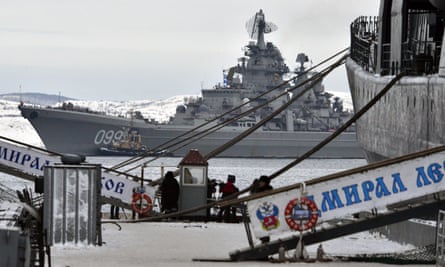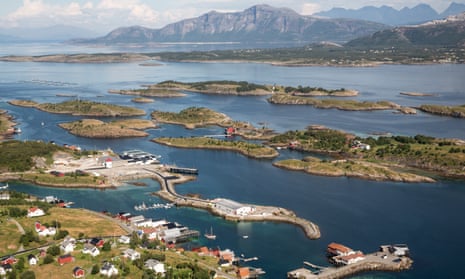If there is one place in Europe that could be most justifiably troubled by Donald Trump’s mysterious relationship with Moscow, it is the windswept coastal town of Bodø lying just inside the Arctic Circle in Norway.
A few minutes’ drive north of Bodø, remote and deep in a vast cave chiselled out of a mountain of quartz and slate, lies Norway’s joint military headquarters, sometimes described as Nato’s northern gate.
The headquarters, halfway between Oslo and Kirkenes, the town closest to Norway’s 122-mile (196km) land border with Russia, is the nerve centre of the country’s efforts to protect itself from an increasingly unpredictable and aggressive neighbour.
At the end of a long, whitewashed tunnel gouged through the mountain in 1963, the NJHQ is an extraordinary construct, built on four floors with sophisticated surveillance equipment beaming pictures of coastal activity, border posts and even al-Jazeera into rooms with banks of screens. At any one time more than 1,000 vessels are being monitored.
The NJHQ commander, Lt Gen Rune Jakobsen, explains that the underground fortress, built by a base run by the Nazi occupiers during the second world war, was envisioned as a place where Norwegian military might survive a nuclear attack by the Soviet Union. “For a while back these headquarters seemed a bit out of date. Now it does not seem such a bad idea again.”
Russia and Norway, he explains, continue to cooperate over coastguard operations, search and rescue and border guards. Jakobsen allows a weekly Skype call to Russia’s Northern Fleet headquarters in Murmansk just to test the line. Otherwise there is silence, and observation.

But the appearance of calm does not mask the fact that the Russian posture in the high north has changed. Moscow has developed a fleet of increasingly sophisticated submarines and aircraft, which are being tested in the north Atlantic alongside new high-precision long-range missiles. The fear is that Nato could lose the ability to deny Russia naval access to the north Atlantic, and Russia could block or disrupt US reinforcement to Europe.
“We are not in a conflict with Russia, and we have never had a border dispute with them in 1,000 years, but after Ukraine we changed our posture,” Jakobsen says. “They are developing new capabilities, especially submarines, very fast. If we leave a vacuum, they will fill it.”
To the other side of Bodø lies an airbase, the home of 25 F-16 fighters, capable of being in the air at 15 minutes’ notice, in response to a call from Nato headquarters in Germany. Two pilots are on duty for 72-hour stretches, and a table lists the annual number of scrambles and IDs, mainly caused by Russian jets flying in international airspace with their transponders switched off. In 2006 it was only 13, but by 2014 the number had risen to 49.
“We call it the Putin effect,” the squadron commander says. “We let things run down for 10 years – response times, equipment – and it is going to take more like 20 year to restore it.”
In this context, Trump’s criticisms of Nato leave the Nordic countries anxious about the alliance’s northern flank. Neighbouring Sweden, which is not in Nato, is also bolstering its defences, announcing this week it is reinstating conscription for both men and women. Finland has released plans to expand its army by 20%.
Norway above all does not see itself as a Nato freeloader, hoarding its oil wealth, but instead a key Nato contributor from which the US benefits.
A senior defence official explains: “We are a nation of only 5 million, but we lie on the threshold of the largest non-western concentration of force in Europe. The modernised Northern Fleet is Russia’s main strategic deterrent, their main nuclear bastion and contains the capabilities to deter and attack the US. It is also the area where the most sensitive testing of Russia’s strategic hardware takes place. We are well placed to monitor this.”
Yet in the 1980s, as the cold war wound down, Nato’s axis began to look away from the Arctic. Nato command and control shifted its point of gravity towards the Mediterranean, as a result of the organisation’s enlargement and a focus on “out of area” operations, such as Afghanistan. Although 50% of the circumpolar region belongs to a Nato member, in 2003 Nato closed its dedicated north Atlantic headquarters in Norfolk, Virginia, while US troops were withdrawn from Iceland.
Few fretted, as they did in the cold war, over the maritime choke point known as the Greenland Iceland UK Gap – the line that Soviet naval forces, including submarine-based nuclear forces, would have to cross in order to reach the Atlantic and stop US forces heading across the sea to reinforce America’s European allies.
In some ways the calm cold war era suited Norway. There is no natural Norwegian wish to be hostile to Russia. Indeed, according to a former commander of the Norwegian Kirkenes force, “the closer to the border, the closer the historical and commercial ties. Borders came late to this region and families lived on both sides. The population of Kirkenes was liberated by the Russians at the end of the second world war. Even now, many adjoining the border hold joint visas and mixed families are not uncommon. Norway is the only neighbouring country with which Russia has not been to war.”Inside the NJHQ there is a cabinet containing the interchange of gifts between the Russian and Norwegian forces over the years, including a glass rifle containing vodka.
Norway’s defence minister, Ine Eriksen Søreide, insisted in an interview in Oslo that Russia is not regarded as a direct threat. But she stresses that post-Georgia and Ukraine, “we are in a new landscape. Russia over time felt it had lost its great power status, but is now talking about legitimate spheres of influence in a new way.

“Since 2008 they have been rebuilding bases in the Arctic, modernising their planes, submarines, and long-range missiles. In Ukraine we have seen their mobility is completely different to the past. In Syria they have shown they can undertake an expeditionary operation that we have not seen since 1979. By firing missiles from the Caspian Sea, they were messaging they can fire them from anywhere. They are trying to put a stranglehold on political progress. In our own country they have shown an ability through cyber to disrupt out politics and economy.”
Senior defence officials, off the record, are even more blunt about the transformation in Russian attitudes, arguing “Putinism” is a recognisable, if opportunistic, post-communist belief system. “It is a nationalistic anti-liberal ideology that has found a ready marketplace in Europe. There is a new influence-seeking.”
Cyber-attacks on government offices and the Norwegian Labour party are attributed by Norwegian intelligence to official Russian actors. Last month the annual threat assessment issued by Norwegian intelligence described Russia as Norway’s biggest threat alongside terrorism, saying it could possibly influence the forthcoming parliamentary elections in the autumn.
Visas for Norwegian MPs have been refused by Russia, and the possible Norwegian active participation in Nato’s nuclear shield – a decision due this year –has provoked Russian officials to claim Norway may become a legitimate target for nuclear attack.
“The shield is purely defensive,” Søreide insists, adding that radars might not be put on land, but on frigates. The stationing of 300 US marines in Norway this year, in effect on a permanent basis, with a massive exercise starting in the north this week, has also led to hostile exchanges.
It is not a complete coincidence that the TV series Occupied, the story of a Russian invasion of Norway during an energy crisis, has become Norway’s most successful series. The series is a kind of Homeland for anxious Europeans.
Overall, the new landscape has forced Norway to raise its defence budget to €5.5bn (£4.8bn), investing in a formidable new range of joint strike aircraft, submarines and spotter planes in what is described as the country’s biggest onshore investment in its history.
This is still not enough to take Norway to Nato’s goal of spending 2% of GDP on defence by 2024. Søreide insists: “Everyone has an obligation to go in the direction of a target. Norway’s journey may take longer since the oil wealth is spurring economic growth.” Norwegian pilots have begun training in the US on the first of more than 50 Lockheed F-35 joint strike aircraft. It is also purchasing five P-8A maritime patrol aircraft to improve its monitoring of the growing Russian submarine presence. In conjunction with Germany, it is buying a new class of submarines capable of matching the latest hard-to-detect Russian submarines. Decisions will be made this year on how to modernise the army.
“We are the gatekeeper of the north on behalf of the alliance,” Søreide promises.
“Russia now has a new ability to threaten all of Europe from their own territory and from the maritime areas of the north Atlantic,” she adds. “This is not war. It is not conflict. It does not mean cruise missiles will rain down in Norway. Conflicts are much more likely to be triggered in the Baltic or the Black Sea, but the strategic balance has shifted, and we all need to be worried.”
